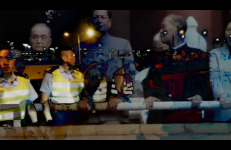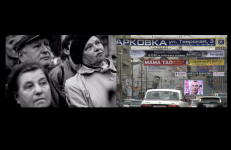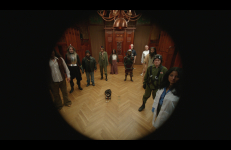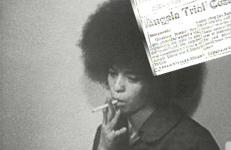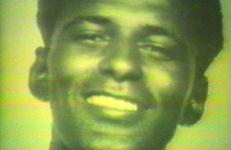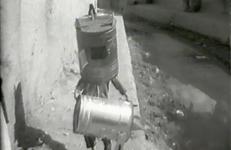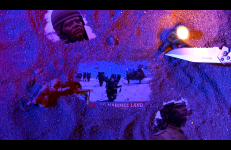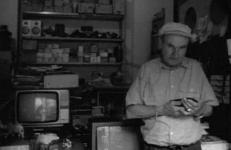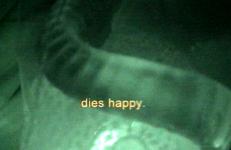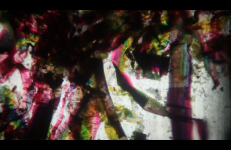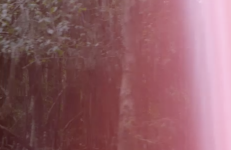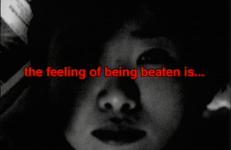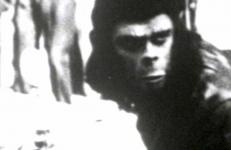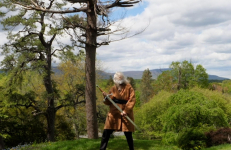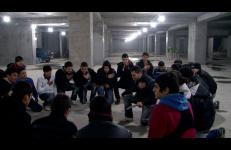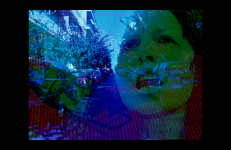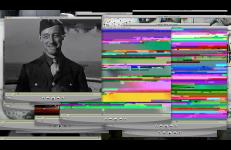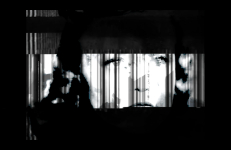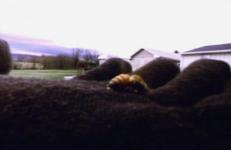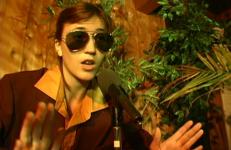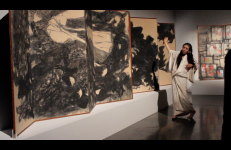This archival film remixes the systemic violence and power throughout the 1984 National Day Parade, the 1989 Tiananmen Square Protests, and the 2014 Umbrella Movement.
History
A wide-screen video diptych of scenes shot during two different periods in Moscow––old footage from 1990 and newer from 2009. There's no linear narrative as the "story" is told principally in the juxtaposition of the two images of the city with this almost 20yr gap. It runs 31 minutes as a single screening, but it is meant to be seen as an installation since its visual theme, from an American perspective, is the recurring cycle of Russian upheaval. It is also principally a "fractal" piece, meaning that its story is replicated in every scene.
–– Ken Kobland
The distant future. An orbital facility of unknown origin. Here, the debt of taking a life will be finally repaid…. through resurrection. The victims of military violence across time are systematically brought back to life and guided through the all-too-familiar facility. As a staff of identical ushers draws back layers of confusion and pain, the freshly resurrected gradually become aware of the reality of their corporeal reinsertion: perhaps the world of the living is not a world at all; to be alive in this place may merely be an exhibit.
The distant future. An orbital facility of unknown origin. Here, the debt of taking a life will be finally repaid…. through resurrection. The victims of military violence across time are systematically brought back to life and guided through the all-too-familiar facility. As a staff of identical ushers draws back layers of confusion and pain, the freshly resurrected gradually become aware of the reality of their corporeal reinsertion: perhaps the world of the living is not a world at all; to be alive in this place may merely be an exhibit.
The distant future. An orbital facility of unknown origin. Here, the debt of taking a life will be finally repaid…. through resurrection. The victims of military violence across time are systematically brought back to life and guided through the all-too-familiar facility. As a staff of identical ushers draws back layers of confusion and pain, the freshly resurrected gradually become aware of the reality of their corporeal reinsertion: perhaps the world of the living is not a world at all; to be alive in this place may merely be an exhibit.
a/k/a Mrs. George Gilbert extends Coco Fusco’s in-depth examination of racialized imagery. Fusco combines fictional and documentary source materials to reflect on the use of electronic surveillance against Black intellectuals and activists in the 1960s and 1970s as part of covert FBI operations. These actions bear a striking resemblance to contemporary Patriot Act-inspired activities of American law enforcement.
Anthony Ramos' astute deconstruction of television news focuses on his part in the media coverage of President Jimmy Carter's 1977 declaration of amnesty for Vietnam draft evaders. Ramos, who had served an 18-month prison sentence for draft evasion, was interviewed by news reporter Gabe Pressman, whose film crew meets Ramos' video crew in a confrontation between technologies and sensibilities. At the time, some broadcast television news crews still used 16mm film, although the expensive transition to ENG (electronic news gathering) systems had begun in 1974.
In 1972 Eric Siegel, an early pioneer of video art, set out on an extreme adventure driving from Europe six thousand miles overland to India. He was one of the first people to use the revolutionary new technology from Sony Corporation, the Portapak. This was the first small portable video camera/recorder combo that was the predecessor of today’s camcorders. Together with his friend Anthony they documented the trip. This video is the portion of the trip that took them through Afghanistan, one of the most exotic places along the way.
Through collage, Alazeef shows the dreams and the fears of a typical Iraqi soldier, a week before the 1991 Desert Storm, compared to the huge war machine. Through poetic narration, Alazeef humanizes the "enemy" and separates the people and soldiers on both sides from political agendas. The control of the mise-en-scene gives the film a radiant surreal feeling.
A portrait of an unnamed city in Italy. Sidestepping the tourist attractions that make the city famous, the film/video posits an almost-imaginary place that draws closer to the reality of its inhabitants. Using a voiceover narration that collages direct observation, literary texts, historical fact, local folklore, and a bit of sheer fabrication, the film/video melds documentary and narrative, past and present.
"I'm not going to go to the Anne Frank House—I don't think I could take it—being a tourist is bad enough—though I'm not really a tourist—I'm here working—my camera's the one on vacation—taking holiday sounds and images—it's having a nice change of pace—for me it's still the same old thing—talking and talking.
This is the audiovisual translation of the Walter Benjamin's Theses on the Philosophy of History.
For four years in the 1860’s, half of the United States was held hostage by an unrecognized white supremacist republic. Shot on 16mm in national military parks, swamps, forests and the suburban sprawl across the former battlefields, the film follows General Grant’s path liberating the southern United States. Part travelogue, part essay film, part landscape documentary, it moves from the Texas-Louisiana border to a prison island off the coast of New England.
Another Clapping explores the relationship triangle between a daughter, her mother and the Chinese Cultural Revolution. It is an experimental documentary based on the mother's violent past with its traumatic political history and an unsuccessful marriage. Through their subsequent experiences as immigrants in Canada and the complex process of remembering and reviewing the past, history comes to signify the characteristic of the individual. The tracing of memory illuminates the difficulties of identifying mother and daughter as different people.
Employing footage from an obscure 8mm film trailer for Battle for the Planet of the Apes to highlight the unstable relationship between the real, historical past and the distant, imaginary future, this project revolves around a central question: Is alien-ness indeed the metaphor for the 20th Century as power relationships have been embodied within our subconscious? Is there a relationship between these forgotten formats and the discontinued political ideologies that they depict?
A psychedelic portrait of the founding theorist of Christianity.
The story of Paul the Apostle’s life, ideology, and influence is told by piecing together 20th century 16mm and cassette propaganda, board games, animation, reenactments, Roman Empire doom metal and covers of Catholic liturgical music. The gentle Paul themes of flute, acoustic guitar, and mellotron contrast with the Demonic Roman Empire themes of electric guitar, drums and synth. Performance artist Linda Mary Montano and Usama Alshaibi portray Paul on his journey.
The Battle of Karbala (680) resulted in the death of Hussein, the grandson of prophet Muhammad and all his supporters. This battle is central to Shi'a Muslim belief in which the martyrdom of Hussein is mourned by an annual commemoration, Ashura. Artist Köken Ergun has worked with Istanbul's Shiite minority, documenting their preparations for the Ashura day.
Note: This title is intended by the artist to be viewed in High Definition. While DVD format is available to enable accessibility, VDB recommends presentation on Blu-ray or HD digital file.
A color-separation portrait of the Exarchia neighborhood of Athens, Greece, made during the Anti-Austerity protests in late 2011. In a place thick with stray cats and scooters, cops and Molotovs, ancient myths and new ruins; where fists are raised like so many columns in the Parthenon, this is a film of surfaces - of grafitti'd marble streets and wheat-pasted city walls - hand-processed in red, green, and blue.
A color-separation portrait of the Exarchia neighborhood of Athens, Greece, made during the Anti-Austerity protests in late 2011. In a place thick with stray cats and scooters, cops and Molotovs, ancient myths and new ruins; where fists are raised like so many columns in the Parthenon, this is a film of surfaces - of grafitti'd marble streets and wheat-pasted city walls - hand-processed in red, green, and blue.
Big_Sleep™ explores problems in our archival urges. Via a single-channel desktop screencast, informatic elements ebb and flow—creating and relating interface absences. These gaps suggest that no amount of hard drive space can defy mortality.
Big_Sleep™ explores problems in our archival urges. Via a single-channel desktop screencast, informatic elements ebb and flow—creating and relating interface absences. These gaps suggest that no amount of hard drive space can defy mortality.
This is the burial hymn for thousands of souls in the anthropocentric times. The ghosts of the American way of life. Part of the Hauntology series.
Blind Huber is a film interpretation of a poem by the American writer Nick Flynn loosely based on the life of Francois Huber, the blind 18th Century beekeeper, who sat before a series of hives for fifty years unlocking an unknown world.
Written by Nick Flynn. Cinematographer: Alex Stockwell.
This title is only available on Broad Daylight and Other Times: Selected Works of Kevin Jerome Everson.
Blood and Guts in High School features actress Stephanie Vella in a series of video installations* that re-imagine punk-feminist icon Kathy Acker's book of the same title. The book received noteriety from 1978-1982 during the rise of Reagan republicanism and the emergence of punk rock. In Parnes' interpretation, each video-chapter presents a typical scene in the life of Janie bracketed by U.S. news events from the time period in which the book was written.
For the November 13, 2015 opening of the Hiroshima Panels by Iri and Toshi Maruki at Pioneer Works, Eiko performed her solo in honor of the Hiroshima Panels and their creators. Japanese-style painter Iri Maruki, born in Hiroshima, and Western-style painter Toshi Maruki, who went into Hiroshima city just three days after the bombing. The artists decided to paint the panels together, which illuminate the human experiences of the Atomic Bomb. They spent 30 years painting the fifteen Hiroshima Panels, six of which were on display at Pioneer Works in Red Hook, Brooklyn.




